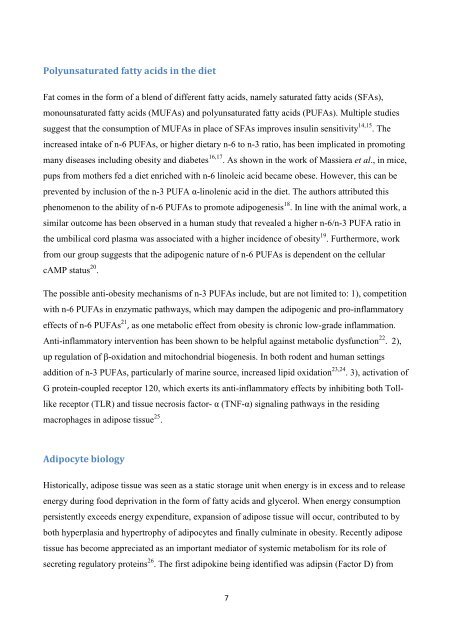The obesogenic effects of polyunsaturated fatty acids are dependent ...
The obesogenic effects of polyunsaturated fatty acids are dependent ...
The obesogenic effects of polyunsaturated fatty acids are dependent ...
You also want an ePaper? Increase the reach of your titles
YUMPU automatically turns print PDFs into web optimized ePapers that Google loves.
Polyunsaturated <strong>fatty</strong> <strong>acids</strong> in the diet<br />
Fat comes in the form <strong>of</strong> a blend <strong>of</strong> different <strong>fatty</strong> <strong>acids</strong>, namely saturated <strong>fatty</strong> <strong>acids</strong> (SFAs),<br />
monounsaturated <strong>fatty</strong> <strong>acids</strong> (MUFAs) and <strong>polyunsaturated</strong> <strong>fatty</strong> <strong>acids</strong> (PUFAs). Multiple studies<br />
suggest that the consumption <strong>of</strong> MUFAs in place <strong>of</strong> SFAs improves insulin sensitivity 14,15 . <strong>The</strong><br />
increased intake <strong>of</strong> n-6 PUFAs, or higher dietary n-6 to n-3 ratio, has been implicated in promoting<br />
many diseases including obesity and diabetes 16,17 . As shown in the work <strong>of</strong> Massiera et al., in mice,<br />
pups from mothers fed a diet enriched with n-6 linoleic acid became obese. However, this can be<br />
prevented by inclusion <strong>of</strong> the n-3 PUFA α-linolenic acid in the diet. <strong>The</strong> authors attributed this<br />
phenomenon to the ability <strong>of</strong> n-6 PUFAs to promote adipogenesis 18 . In line with the animal work, a<br />
similar outcome has been observed in a human study that revealed a higher n-6/n-3 PUFA ratio in<br />
the umbilical cord plasma was associated with a higher incidence <strong>of</strong> obesity 19 . Furthermore, work<br />
from our group suggests that the adipogenic nature <strong>of</strong> n-6 PUFAs is <strong>dependent</strong> on the cellular<br />
cAMP status 20 .<br />
<strong>The</strong> possible anti-obesity mechanisms <strong>of</strong> n-3 PUFAs include, but <strong>are</strong> not limited to: 1), competition<br />
with n-6 PUFAs in enzymatic pathways, which may dampen the adipogenic and pro-inflammatory<br />
<strong>effects</strong> <strong>of</strong> n-6 PUFAs 21 , as one metabolic effect from obesity is chronic low-grade inflammation.<br />
Anti-inflammatory intervention has been shown to be helpful against metabolic dysfunction 22 . 2),<br />
up regulation <strong>of</strong> β-oxidation and mitochondrial biogenesis. In both rodent and human settings<br />
addition <strong>of</strong> n-3 PUFAs, particularly <strong>of</strong> marine source, increased lipid oxidation 23,24 . 3), activation <strong>of</strong><br />
G protein-coupled receptor 120, which exerts its anti-inflammatory <strong>effects</strong> by inhibiting both Tolllike<br />
receptor (TLR) and tissue necrosis factor- α (TNF-α) signaling pathways in the residing<br />
macrophages in adipose tissue 25 .<br />
Adipocyte biology<br />
Historically, adipose tissue was seen as a static storage unit when energy is in excess and to release<br />
energy during food deprivation in the form <strong>of</strong> <strong>fatty</strong> <strong>acids</strong> and glycerol. When energy consumption<br />
persistently exceeds energy expenditure, expansion <strong>of</strong> adipose tissue will occur, contributed to by<br />
both hyperplasia and hypertrophy <strong>of</strong> adipocytes and finally culminate in obesity. Recently adipose<br />
tissue has become appreciated as an important mediator <strong>of</strong> systemic metabolism for its role <strong>of</strong><br />
secreting regulatory proteins 26 . <strong>The</strong> first adipokine being identified was adipsin (Factor D) from<br />
7
















